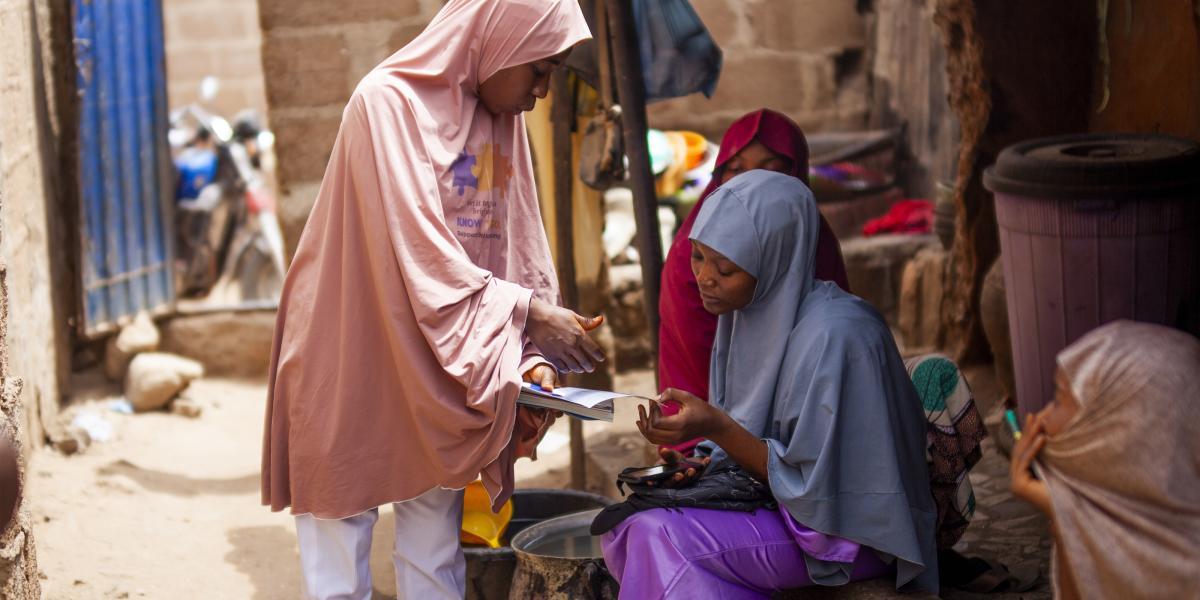What’s Next for Family Planning?
Reeling from aid cuts, the sexual and reproductive health community comes together to make its way forward.
Innocent Grant can’t shake memories of southern Tanzanian gynecology wards. About half of the patients he saw, on rounds as a student, were suffering from sepsis following an incomplete abortion—often obtained on the streets because abortion is illegal in Tanzania.
Young unmarried women who get pregnant there are often barred from school and lack employment options, says Grant, who was studying to become a clinical medical officer at the time. Now, he is a Bloomberg School MSPH student and a research assistant for the William H. Gates Sr. Institute for Population and Reproductive Health (WHGI), where, until February, he had worked on USAID-funded programs providing vocational training and support to young mothers—projects that have all been terminated or placed on hold.
“All those initiatives are now being shut down, and being demonized in a sense,” says Grant, “even though we know for sure they’re saving lives.” He points to evidence that Tanzania achieved an 82% reduction in maternal mortality, for example, which he attributes to huge investments by development partners including USAID.
Of all sectors hit by the U.S. administration’s dismantling of USAID, the sexual and reproductive health rights community faces some of the steepest challenges.
The sudden changes to U.S. foreign assistance threw the sector into chaos.
“At the beginning of the year, we thought, ‘OK, we’ve seen this before. No abortion.’ But this time, everything has been cut off,” Marta Royo, executive director of Profamilia Colombia and a member of the International Conference on Family Planning’s (ICFP) national steering committee. “So many important programs, even beyond health issues, are already being impacted.”
“Nothing’s going to replace USAID,” says Philip Anglewicz, PhD, MA, director of WHGI, “but there are people and groups that can step in and fill some of this void and also assess the priorities that we have with this shrinking pie.” That will require a stark appraisal of the lives most at risk, he says, and evaluating how things were done in the past and asking if there is a more effective and efficient way forward.
The family planning community held a convening in March co-hosted by the WHGI and the FP2030 global partnership to begin this work—processing the impact of the cuts, determining how to move forward, and seeking potential new partners and donors.
Family planning advocates have long been working different angles to explain the sector’s importance to people outside their community—emphasizing, for example, the economic benefits of ensuring that family planning services are available to women who want them.
“We know that family planning is a ‘best buy,’” says Samukeliso Dube, MD, MPH, MBA, director of FP2030 and an ICFP core organizing group member, noting that every dollar invested in family planning yields up to $8.78 in return.
Such economic arguments have resonated more with skeptics than the health arguments, says Marie Ba, director of the Ouagadougou Partnership Coordination Unit for francophone West Africa. “Anytime we’ve talked in terms of the economic contributions that women make to several different industries, that has resonated much more,” Ba says. “So we try to speak in a different language now.”
The field has weathered setbacks before, albeit on a much smaller scale, such as the Global Gag Rule and the Dobbs ruling, Anglewicz and others note. They argue that the cuts are an opportunity to pause, reflect, and strengthen as a community.
“So many of the standards, the policies, were dictated and written by USAID. Some of it good, some of it not so good, especially in terms of global equity, and the part that the Global South plays,” Ba says.
That’s another reason for countries to carve out more independence—and to mobilize more domestic funding for reproductive health and family planning services. But stepping up domestic funding isn’t a realistic option for many countries. Even among those better positioned to cover more costs, many will not prioritize reproductive health and family planning, Dube says.
Still, the March convening reflected the clear energy of determination. “Participants spoke with urgency and conviction, demonstrating a collective commitment to safeguarding the future of family planning,” Anglewicz says, adding that he was “struck by the momentum building behind a more structured and strategic movement for family planning and foreign assistance.”
The choice of Colombia to host the ICFP 2025 conference in November has yielded unexpected benefits, says Anglewicz. Latin America has already largely transitioned from USAID funding for family planning and reproductive health to domestic funding. Their lessons learned might help other countries.
“This involves things like looking at the role of the private sector for financing and the increasing prominence of private sector, considerations about equity, and south-to-south meetings to help foster dialogue and learning from the experience of Latin America,” he says.
Royo acknowledges that challenges related to sexual and reproductive health rights—especially adolescent pregnancy and violence against women—persist in the region. But she also points to success stories. Colombia, for example, has folded reproductive health services into primary health care services for decades. In the last decade, Profamilia and other groups have bolstered private sector partnerships for financing and increased local production of family planning commodities like contraception as well as pregnancy and STI tests.
She also sees ICFP as a chance to reflect on lessons learned and surface topics that the community suppressed for years for fear of losing U.S. funding. “We were told not talk about or do anything related to abortion. … Did avoiding that stop what is happening right now? No, no, it didn’t,” Royo says. “Sexual and reproductive health rights [have] become more political than ever, but we have to turn that around and ask, how can we change it from being something that antagonizes people and communities, into something that brings us together?”
